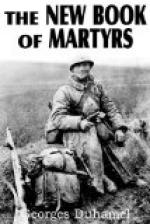Each sufferer has his characteristic cry when the dressing is going on. The poor have only one, a simple cry that does service for them all. It makes one think of the women who, when they are bringing a child into the world, repeat, at every pain, the one complaint they have adopted.
Carre has a great many varied cries, and he does not say the same thing when the dressing is removed, and when the forceps are applied.
At the supreme moment he exclaims: “Oh, the pain in my knee!”
Then, when the anguish abates, he shakes his head and repeats:
“Oh, that wretched knee!”
When it is the turn of the thigh, he is exasperated.
“Now it’s this thigh again!”
And he repeats this incessantly, from second to second. Then we go on to the wound under his heel, and Carre begins:
“Well, what is wrong with the poor heel?”
Finally, when he is tired of singing, he murmurs softly and regularly:
“They don’t know how that wretched knee hurts me... they don’t know how it hurts me.”
Lerondeau, who is, and always will be, a little boy compared with Carre, is very poor in the matter of cries. But when he hears his complaints, he checks his own cries, Borrows them. Accordingly, I hear him beginning:
“Oh, my poor knee! ... They don’t know it hurts!”
One morning when he was shouting this at the top of his voice, I asked him gravely:
“Why do you make the same complaints as Carre?”
Marie is only a peasant, but he showed me a face that was really offended:
“It’s not true. I don’t say the same things.”
I said no more, for there are no souls so rugged that they cannot feel certain stings.
Marie has told me the story of his life and of his campaign. As he is not very eloquent, It was for the most part a confused murmur with an ever-recurring protestation:
“I was a good one to work, you know, strong as a horse.”
Yet I can hardly imagine that there was once a Marie Lerondeau who was a robust young fellow, standing firm and erect between the handles of a plough. I know him only as a man lying on his back, and I even find it difficult to picture to myself what his shape and aspect will be when we get him on his feet again.
Marie did his duty bravely under fire. “He stayed alone with the wagons and when he was wounded, the Germans kicked him with their heavy boots.” These are the salient points of the interrogatory.
Now and again Lerondeau’s babble ceases, and he looks up to the ceiling, for this takes the place of distance and horizon to those who lie upon their backs. After a long, light silence, he looks at me again, and repeats:
“I must have been pretty brave to stay alone with the wagons!”
True enough, Lerondeau was brave, and I take care to let people know it. When strangers come in during the dressings, I show them Marie, who is making ready to groan, and say:




